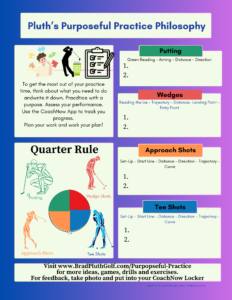Golf gets easier when your mindset does the heavy lifting. A good swing without a good picture is guesswork; a clear picture turns the swing into a rehearsal. This post gives you a fast, repeatable Visualization Checklist that fits inside a 30-second pre-shot routine for full swing and putting. You’ll also learn quick drills, common mistakes, and a simple way to track progress.
Why visualization works (plain English)
Visualization is mental simulation—you preview the shot you’re about to hit using sight, feel, and sound. Research in performance psychology shows mental rehearsal recruits many of the same neural pathways you use during movement. On course, that means:
- less “swing clutter” (fewer mechanical thoughts),
- stronger target commitment, and
- a calmer autonomic system (lower heart rate spikes) so speed and tempo stay stable.
- Brain reacts to images and questions. Frame them well and you’ll transform your performance.
The 30-Second Pre-Shot Visualization Routine
Keep it short. Every step has a purpose. If you can’t do it in 30 seconds when it matters, trim it.
- Cue (1–2 sec): Step behind the ball. Exhale. Soft focus on the fairway/green.
- Target Picture (3–4 sec): Pick a precise start line and final finish (e.g., left edge of the 150 marker; 8 feet past the front ridge).
- Context Check (3–4 sec): Lie, slope, wind, carry/land/roll. Choose shot shape and height accordingly.
- One Feel (4–6 sec): Rehearse the motion that matches the picture (tempo, face feel, release, or ground pressure). One cue only.
- Breath (3–4 sec): Nose in, slow mouth out. Drop the shoulders.
- Alignment (4–5 sec): Aim the clubface first at your start line; set feet/hips/shoulders parallel.
- Trigger (1 sec): A simple start signal (soft waggle, heel tap, “two-count”).
- Commit (swing/roll): No new thoughts. Picture → feel → go.
Mantra: See it. Feel it. Trust it.
The Golf Visualization Checklist (printable section)
- Precise target + start line chosen
- Landing zone & roll accounted for
- Wind/lie/slope considered
- Shot shape & height selected
- One rehearsal feel (not three)
- Calm exhale before walking in
- Face aimed first, body matched
- Simple trigger → full commitment
Variations for common situations
Tee shots (driver/fairway)
- Picture: Window through the trees/clouds; apex height; ball finishing on a stripe of fairway.
- Feel: Width + tempo or specific start-line feel (e.g., “hold face to right edge”).
- Miss plan: Choose your good miss (e.g., right half only). Commit to it.
Approach shots (irons/wedges)
- Picture: Land spot, first bounce, roll-out. See the ball climb, fall, and stop.
- Feel: Strike and low-point—one crisp rehearsal with the turf.
- Wind: Use a height cue (“window”) instead of re-engineering your swing.
Around the green
- Picture: Trajectory window + landing dot; imagine the second bounce speed.
- Feel: Length of motion that matches the landing dot—no extra thoughts.
Putting
- Picture: Start line through a specific dimple on the ball; see the ball rolling into the entry point of the hole and make that you last look. Pro tip: take a one second look at the entry point!
- Feel: Length/tempo matching the distance. One preview stroke with eyes on the target, not the ball.
- Trigger: Set, exhale, roll.
Drills to hardwire the routine
1) Nine-Window Range Game (full swing)
Pick a 40-yard wide corridor downrange. Hit 9 balls: low/mid/high draws; low/mid/high stock; low/mid/high fades. Visualize first, then swing. Score: +1 if ball starts on intended start line window; 0 otherwise.
2) Land-Spot Ladder (wedges)
Place alignment rods or towels at 10-yard increments (e.g., 30/40/50). Call the exact landing spot, visualize the bounce/roll, then hit. Record carry and total—aim for <10% dispersion.
3) Start-Line Gate (putting)
Create a gate with tees 2–3 feet in front of the ball, slightly wider than the ball. Visualize the roll and start line, then roll 10 putts. Goal: 8/10 through the gate with consistent finish distance (12–18 inches past).
4) 3-Breath Reset (any shot)
When pressure spikes, step back and use three slow breaths: 4 sec inhale, 6 sec exhale, shoulders down. Then rebuild the picture → feel → commit.
Common mistakes (and fixes)
- Vague targets. Fix: always choose a knife-edge target (leaf, dimple, sprinkler head).
- Too many swing thoughts. Fix: one feel only. Park mechanics at practice; compete on course.
- Rushing. Fix: one calm exhale behind the ball before walking in.
- No miss plan. Fix: choose a safe-side good miss before you swing.
- Staring at trouble. Fix: acknowledge it once, then move your eyes to the start line and final finish.
- Aiming away from trouble: ALWAYS aim AT a target.
Mindset cues you can actually use
- Process > outcome: Your job is to build the picture and make a committed swing. The ball is a result, not a verdict.
- Confidence = clarity + repetition: The more often you run the same simple routine, the calmer your system becomes.
- Scoreboard patience: Small wins (start line, speed control) compound. Chase consistency, not miracles.
How to track progress (simple scorecard)
On each hole, give yourself a point for each:
- Chose a precise target/start line
- Used one feel rehearsal
- Made a committed swing/roll (no mid-stroke doubt)
18-hole goal: 40+ points = strong process day, regardless of score. Process leads; score follows.
FAQ (quick answers for searchers)
Does visualization actually lower scores?
Yes—players see faster improvements in start line, speed control, and decision making, which drive scoring.
How long should a pre-shot routine take?
About 20–30 seconds. Any longer invites overthinking; any shorter risks skipping key steps.
What should I think before I swing?
Picture the shot and recall one feel that matches the picture. Then commit.
How do I calm nerves before a shot?
Slow exhale, eyes to the target, narrow your thought to one cue, and run your routine.
Ready to put it to work?
Use the checklist in your next round. If you want a personalized routine with TrackMan, GEARS, BodiTrak, feedback, book a Baseline + Blueprint session.
Complete the Evaluation to help you think through your process.
| 0 | 1 | 2 | 3 | 4 | 5 |
| Does not Apply | Never | Seldom | Sometimes | Usually | Always |
| Check the number that applies | 0 | 1 | 2 | 3 | 4 | 5 |
| I have trouble seeing myself being successful | ||||||
| I need frequent reassurance about my success | ||||||
| I think about what I should not do | ||||||
| I see myself failing | ||||||
| I focus on where not to hit my shot | ||||||
| I am negative. | ||||||
| I focus on what not to do | ||||||
| I do not have written 1 year goals | ||||||
| I am suspicious of others | ||||||
| I have no dreams about my future | ||||||
| I anticipate problems | ||||||
| I do not have precise goals (Dreams) | ||||||
| I focus on the success of others | ||||||
| . I get bogged down with obstacles that block my goals | ||||||
| My mind drifts to negative anticipation | ||||||
| I have intrusive thoughts of hazards as I address my ball | ||||||
| 0 | 1 | 2 | 3 | 4 | 5 | |
| I focus on my past failures as I plan for the future | ||||||
| I am fearful of repeating past failures | ||||||
| I believe I will not succeed | ||||||
| I have intrusive thoughts of my past failures | ||||||
| I have trouble motivating myself | ||||||
| I see myself as less than others | ||||||
| I need to look good for others | ||||||
| I avoid social situations | ||||||
| My mental pictures are negative | ||||||
| Small problems occupy my mind | ||||||
| I have intrusive thoughts of past bad shots as I set up to the ball. | ||||||
| My “dreams” are hampered by my life’s circumstances | ||||||
| I give up on projects when I encounter difficulty | ||||||
| I do not make list of things I want to get done | ||||||
| I stand over a shot with no plan or target | ||||||
| I never seem to get to the things I like to do | ||||||
| My life is filled with small things that block my dreams |
Step Two: email pluthb@pga.com with a copy. I’ll send a link to schedule a 15-minute call to connect and provide improvement options.
Step Three: Execute the improvement plan and enjoy training and playing better golf!



